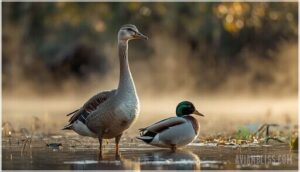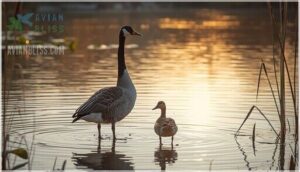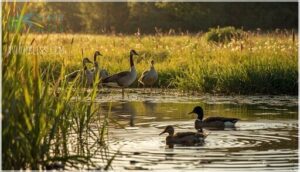This site is supported by our readers. We may earn a commission, at no cost to you, if you purchase through links.

Geese cruise at 40 mph in energy-saving V-formations while ducks rocket past at 60 mph on stubby wings, each species carving out its own ecological niche through thousands of years of specialized adaptation.
Understanding these differences reveals how two waterbirds sharing the same family tree evolved such contrasting approaches to feeding, defending territory, and conquering continental migrations.
Table Of Contents
- Key Takeaways
- Goose and Duck Characteristics
- Behavioral and Habitat Differences
- Flight and Swimming Abilities
- Frequently Asked Questions (FAQs)
- What is the difference between a goose and a duck?
- How big is a duck compared to a geese?
- Do geese have longer bills than ducks?
- What are the similarities and differences between ducks and geese?
- What is the difference between a white goose and a duck?
- Is duck better than goose?
- What is the difference between a duck and goose?
- Are geese related to ducks?
- Is goose more expensive than duck?
- Are ducks or geese more friendly?
- Conclusion
Key Takeaways
Geese stand out with their long necks, heavier bodies, and muted plumage, while ducks are smaller, brightly colored, and built for quick paddling and flying.
Geese are fiercely territorial and graze mostly on land, but ducks are social, adaptable omnivores that feed in water and form fluid flocks.
Migration patterns differ: geese travel vast distances in energy-saving V-formations, while ducks cover shorter routes and change timing based on food and habitat.
Flight and swimming styles reflect their evolution—geese cruise steadily for endurance, while ducks rely on bursts of speed and maneuverability.
Goose and Duck Characteristics
When you spot a waterfowl waddling by, you might wonder if you’re looking at a goose or a duck. These birds share the same family tree, but they’re built quite differently—from their frame and feathers to their beaks and necks.
Let’s break down what sets them apart so you can tell one from the other at a glance.
Physical Appearance Differences
Appearance matters when spotting these waterfowl in the wild. Though both geese and ducks belong to the Anatidae family, you’ll notice distinct differences:
- Neck bones and body proportions – Geese have 17 to 24 cervical vertebrae creating their signature long necks, while ducks max out at 16, giving them a compact body shape.
- Beak shapes and feather texture – Duck bills are wider and flatter for filter-feeding, whereas goose bills are shorter and triangular for grazing tough vegetation.
- Plumage patterns and coloration – Ducks display vibrant greens and blues with intricate patterns, while geese sport muted grays and browns with softer feathers.
Their leg structure also differs, with geese standing taller for better land mobility. Understanding the size and weight differences is essential for identifying these birds in their natural habitats.
Size and Shape Distinctions
You’ll immediately notice the size gap when comparing these birds. Adult geese stretch 30–50 inches and tip the scales at 10–20 pounds, while ducks measure just 15–25 inches and weigh a modest 2–5 pounds.
Body proportions reveal more: geese sport longer necks with up to 24 neck bones versus ducks’ maximum of 16, creating that signature elongated profile. Their leg structure differs too—geese stand upright for grazing, while ducks waddle low with rear-set legs built for paddling.
Understanding the webbed feet benefits is essential for their swimming abilities.
Neck and Beak Variations
Beyond size differences, neck musculature and beak shapes tell the real story. Geese stretch their necks—averaging 35 to 60 cm with up to 24 neck bones—to graze on grasses below water surfaces, while ducks work with compact 10 to 25 cm necks built for quick strikes at insects. Visual differences extend to their bills: geese sport tapered beaks (65–80 mm) with rougher surfaces for mowing vegetation, whereas ducks display diverse beak sensitivity adaptations, from spatula-shaped filters to narrow pointers (30–50 mm). Morphometric analysis confirms these feeding adaptations match their ecological niches perfectly.
- Goose necks: Thick, muscular structures reaching vegetation deeper underwater without fatigue
- Duck bills: Tactile nerve endings detect prey in murky water through bill shape characteristics
Plumage Characteristics
Feather structure reveals why ducks often steal the spotlight. You’ll notice male ducks sporting iridescent blues and greens—over 58% of duck species show striking sexual dimorphism, where drakes outshine hens by orders of magnitude. Geese? They’ve opted for uniformity, with both sexes wearing matching gray, brown, or white tones.
Beneath the surface, ducks pack denser feather arrangements—52 barbules per millimeter versus 38 in geese—creating enhanced waterproof barriers with contact angles exceeding 150°. That preen gland oil isn’t just for show; it maintains hydrophobicity through repeated dives.
Geese counter with thicker down clusters, delivering 2.5 clo insulation units, trumping duck plumage at 2.1 units. Molting cycles differ too: ducks undergo two annual transformations, including eclipse plumage, while geese molt once after goslings fledge.
Behavioral and Habitat Differences
Beyond the obvious physical differences, geese and ducks lead surprisingly different lives. Their personalities, dining habits, and choice of real estate couldn’t be more distinct.
Let’s look at how these birds behave and where they prefer to set up camp.
Social and Territorial Behaviors
When geese defend their turf, they mean business—ganders spend up to 90% of daylight hours protecting nests, often charging intruders within a 10-meter zone. Their Territorial Defense intensity peaks during breeding, with flocks showing strong Social Hierarchy and aggressive Agonistic Behavior reaching 0.45 interactions per minute. Pair Bonding lasts decades, strengthening their territoriality.
Ducks? They’re the diplomats—forming temporary Flocks with fluid dynamics, seasonal bonds, and conflicts rarely exceeding 10 seconds, making their Behavior far less confrontational.
Vocalization and Communication
You’ll notice geese honk louder and more often—greylag males hit 3,081 Hz while females reach 2,518 Hz—but ducks deliver acoustic surprises with up to 16 distinct vocalization types across different communication styles.
Call Recognition in Waterfowl reveals that geese respond to partner calls 78% of the time (nearly ignoring strangers), while duck sound patterns shift dramatically with female flocks showing richer vocal learning and communication diversity.
These acoustic signals shape behavior: geese use sustained distance calls exceeding 300 milliseconds for pair bonding, whereas duck vocalizations serve shorter, situation-specific alerts and social coordination.
Feeding Habits and Foraging
Regarding table manners, geese and ducks couldn’t be more different dinner guests. You’ll find geese grazing like miniature lawn mowers, spending 50-60% of daylight hours cropping grasses, clover, and sedges close to the ground—they’re committed herbivores with a taste for agricultural leftovers like corn and wheat. Ducks? They’re the opportunistic omnivores of the waterfowl world, with dabbling species tipping forward in shallow water to snag aquatic vegetation while diving ducks plunge deep for protein-rich insects and fish eggs. Their dietary split reflects distinct foraging techniques and nutrient intake strategies shaped by habitat and season.
- Geese consume higher-fiber diets dominated by terrestrial grasses, while ducks balance 70-80% plant material with 20-30% animal protein
- Ducks spend only 30-40% of daylight feeding, thanks to their efficient protein conversion from diverse aquatic vegetation and invertebrates
- Geese dabble occasionally for underwater roots and stems but lack the diving prowess of their duck cousins
- Seasonal shifts matter: geese load up on carbohydrate-rich seeds before migration, while ducks maintain year-round dietary flexibility
- Young ducklings rely heavily on insects for growth protein, unlike goslings raised on vegetation from day one
Habitat Preferences and Adaptations
Think of habitat selection as real estate shopping—location, location, location. You’ll spot geese claiming open wetlands and agricultural landscapes, where daily territories average 8.2 km² during seasonal transitions, while ducks exploit microhabitat diversity from forested sloughs to deep lakes at finer 1-hectare scales.
Geese select wet rice fields heavily at night during migration, then shift toward drier habitats as flooding ages, whereas ducks maintain year-round flexibility, adapting foraging patterns to hydrologic conditions and drought-proof water sources.
Landscape connectivity, microhabitat features like islands, and aquatic vegetation density drive these waterfowl’s climate adaptation strategies differently.
Flight and Swimming Abilities
Regarding mobility, geese and ducks have adapted their bodies in surprisingly different ways. You’ll notice these differences most clearly when you watch them take off from water or glide across a pond.
Let’s break down how each bird moves through air and water, and why those migration patterns look so distinct.
Flight Speed and Efficiency
Ducks average 40-60 mph in flight, though some species clock up to 81 mph—but geese reign dominant with cruising speeds of 30-40 mph that spike to 70 mph during migration.
Their aerodynamic principles shine in V-formations, where wing morphology adjustments and strategic positioning slash energy costs by up to 16%.
This migration efficiency lets geese complete thousand-mile journeys with fewer pit stops, while ducks’ shorter wings demand more frequent refueling despite their impressive burst speed.
Swimming Speed and Mechanics
When you watch waterbirds glide across a pond, you’re witnessing two distinct swimming techniques shaped by millions of years of evolution. Ducks zip along at 2–6 mph, with mallards hitting bursts near 20 mph using hydrodynamic forces generated by their webbed feet. Geese paddle steadier at 3.4–4.5 mph, conserving energy through aerodynamic body positioning.
Diving ducks demonstrate impressive aquatic maneuverability, descending at controlled speeds while their water-repellent plumage reduces feather resistance.
Formation swimming reveals another trick: trailing ducklings exploit wave propulsion created by the leader, cutting drag by up to 158%. These Anatidae family members prove that swimming speed isn’t everything—efficiency matters more for survival.
Migration and Movement Patterns
Migration reveals another striking contrast you’ll notice between these waterfowl. Geese tackle epic journeys—Canada geese can exceed 4,000 miles—flying in those unmistakable V-formations that conserve energy through reduced air resistance. They’re loyal to their Migration Routes, using 2-4 Stopover Sites where they’ll rest up to 40 hours in autumn. Ducks show more flexibility: their Flight Patterns scatter across shorter distances, adapting quickly to shifting Habitat Use and food supplies.
Both Migratory birds navigate using sun, stars, and magnetic fields, but geese maintain stricter schedules while ducks improvise their timing based on environmental cues.
- Climate change has shifted their traditional patterns, pushing some populations to winter farther north than previous generations ever did.
Frequently Asked Questions (FAQs)
What is the difference between a goose and a duck?
You’ve probably noticed waterfowl at the park and wondered which are which. Geese tower over ducks with their longer necks and heavier builds, while ducks stay compact and colorful—ducks are the quick flyers, geese the vocal wanderers.
How big is a duck compared to a geese?
Compared to geese, ducks are noticeably smaller in body size, weight, and length. Most ducks weigh between 1-13 pounds, while geese usually range from 6-26 pounds—often doubling a duck’s weight and wingspan.
Do geese have longer bills than ducks?
Yes, geese generally have longer bills than ducks. Canada Geese bills measure around 7-11 cm, while Mallard duck bills are shorter at 4-1 cm, reflecting their different feeding strategies and ecological niches.
What are the similarities and differences between ducks and geese?
If you’re seeking backyard drama, Geese deliver grand entrances and territorial honking, while Ducks keep things light with prolific egg laying and colorful antics.
Both Anatidae stars share migration patterns, feather care rituals, and clever beak functions.
What is the difference between a white goose and a duck?
A white goose stands taller, with a long neck and soft, pale plumage, grazing in open fields.
Ducks, in contrast, are smaller, brightly colored, and quick swimmers, with broader beaks and varied feeding patterns—especially during breeding habits and migrations.
Is duck better than goose?
Duck or goose—it’s all about your priorities. Ducks excel at Egg Production and offer tender meat, while geese win in Lifespan Factors and make vigilant pets.
Diet Comparison, Meat Nutrition, and Flight Speed tip the scales differently for each.
What is the difference between a duck and goose?
Let’s not ruffle any feathers: Comparing geese and ducks reveals clear physical differences. Geese boast longer necks, heavier bodies, and more aggressive Migration Patterns, while ducks display brighter plumage, diverse Beak Functions, and adaptable Feeding Habits.
Are geese related to ducks?
Geese and ducks share strong Family Ties within the Anatidae clan of waterfowl. Their Genetic Link and Evolution History reveal common Ancestral Roots, making them close relatives—think distant cousins with different quirks, both thriving as water birds.
Geese and ducks are close relatives in the Anatidae family, sharing deep evolutionary roots but sporting their own unique quirks
Is goose more expensive than duck?
Goose is generally more expensive than duck, thanks to its larger size, higher retail costs, and culinary prestige.
Market trends show geese command a premium, reflecting consumer demand and meat production differences in the goose vs duck comparison.
Are ducks or geese more friendly?
Friendly feathers flock in fascinating ways: ducks display docile behavior and social bonds, making them approachable.
Geese, with higher aggression levels and intense parental care, require patience and trust.
Both offer unique emotional intelligence and rewarding human interaction.
Conclusion
Picture a pond at sunrise: the goose glides in stately procession, while the duck darts with restless curiosity. This daily drama isn’t just theater—it’s evolution in motion.
Goose vs duck isn’t a rivalry, but a demonstration of nature’s ingenuity, sculpting two distinct paths for survival. Whether you admire the goose’s disciplined formations or the duck’s nimble maneuvering, you’re witnessing specialized adaptations that have shaped each bird’s role in the wild tapestry of life.
- https://www.trvst.world/biodiversity/goose-vs-duck/
- https://pmc.ncbi.nlm.nih.gov/articles/PMC10667451/
- https://foodstruct.com/nutrition-comparison/domestic-goose-vs-duck-meat
- https://www.sciencedirect.com/topics/agricultural-and-biological-sciences/anatidae
- https://www.cambridge.org/core/journals/journal-of-fluid-mechanics/article/waveriding-and-wavepassing-by-ducklings-in-formation-swimming/94759A0FF7070D9D7CAC5907594B1781









